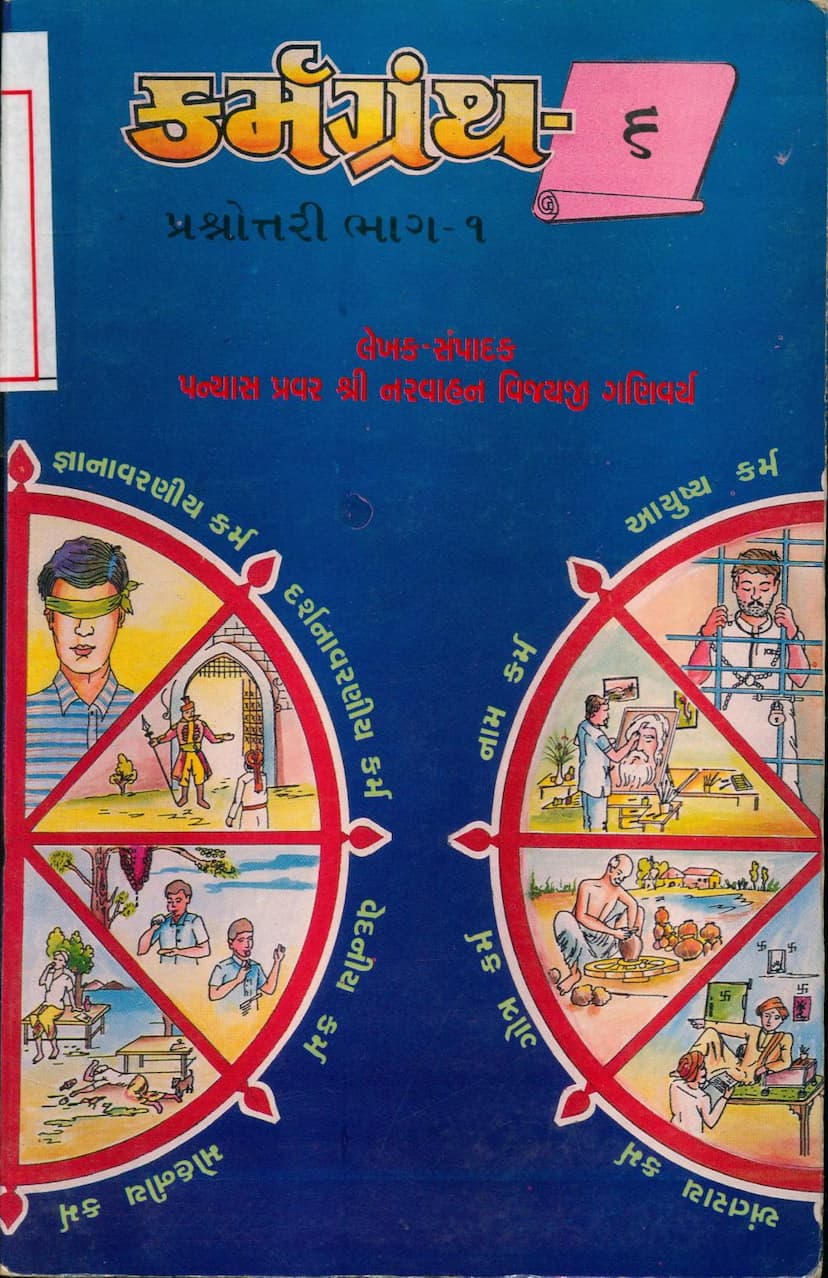Karmgranth 6 Prashnottari Part 01
Added to library: September 2, 2025

Summary
Here's a comprehensive summary of the Jain text "Karmgranth 6 Prashnottari Part 01" by Narvahanvijay, published by Padarth Darshan Trust:
This book, "Karmgranth 6 Prashnottari Part 01," is the first part of the sixth volume in the "Karmgranth" series, presented in a question-and-answer format. It is authored and edited by Pujya Nyas Pravar Shri Narvahan Vijayji Ganivarya.
Core Subject Matter:
The book delves into the intricate subject of Karma (actions and their consequences) in Jainism. It aims to make this complex topic more accessible to students and seekers of spiritual knowledge. The primary focus is on analyzing the bandh-uday-satta (bondage, manifestation, and latent state) of karmic matter, along with its various permutations and combinations known as bhangas (modes or variations).
Key Concepts Explained:
The text systematically defines and explains fundamental Jain concepts related to karma:
- Bandh Sthanak (Bondage Place): The collection of karmic dispositions that are bound by a soul at a particular time.
- Uday Sthanak (Manifestation Place): The collection of karmic dispositions that a soul is experiencing (in manifestation) at a particular time.
- Satta Sthanak (Latent State Place): The collection of karmic dispositions that remain in a soul's latent state at a particular time.
- Bandh Bhanga (Bondage Modes): The classification of karmic dispositions bound by a soul at one time, after differentiating between opposing dispositions.
- Uday Bhanga (Manifestation Modes): The karmic dispositions experienced by a soul at one time, after differentiating between opposing dispositions. This is further elaborated by multiplying the 24 types of karmic dispositions.
- Uday Pad (Manifestation Term): The collection of terms or words related to the manifestation modes of Mohaniya Karma (delusion-inducing karma).
- Padavrund (Term Group): The collection of terms obtained by multiplying the Uday Pad by 24.
- Chovishee Bhanga (Twenty-four Modes): A combination of 24 modes.
- Shodashak Bhanga (Sixteen Modes): A combination of 16 modes.
- Ashtak Bhanga (Eight Modes): A combination of 8 modes.
- Samvedh Bhanga (Conjunction Modes): A comprehensive consideration of bondage, manifestation, and latent states.
Source Material and Methodology:
The author states that the knowledge presented in this book is drawn from sacred Jain texts like the Karmapraabhrut and Karmaprakruti, which are based on the teachings of omniscient beings. Specifically, the content is derived from the Drishtivaad, the twelfth Anga of the Jain Agamas, particularly from the Agrayani Purva and the Karmaprakruti Praabhrut within it. The book aims to present a condensed version of the vast knowledge contained in these scriptures.
Structure and Content:
The book extensively uses a question-and-answer format to clarify the complex concepts of karma. It systematically breaks down the subject by:
- Defining Key Terms: Explaining the meaning of various karmic states and classifications.
- Analyzing Karma Types: It details the number of dispositions (prakritis) for each of the eight karmas (Gnanavaraniya, Darshanavaraniya, Vedaniya, Mohaniya, Ayushya, Nama, Gotra, Antaraya).
- Mapping to States and Stages: It meticulously maps the bondage, manifestation, and latent states, as well as the Samvedh Bhangas, to different Jeev Bhed (types of souls/beings) and Gun Sthanak (stages of spiritual development).
- Detailed Breakdowns: The text provides specific numbers of these states and their occurrences across various Margaṇās (categories of classification, such as life forms, senses, motivations, etc.). This includes extensive tables and lists of these correlations.
Specific Karma Analysis:
The book provides detailed explanations and tabulations for:
- Jnanavaraniya Karma (Knowledge Obscuring Karma): Discusses its dispositions, states, and Samvedh Bhangas in relation to various Marganas and Gun Sthanaks.
- Darshanavaraniya Karma (Perception Obscuring Karma): Similarly, analyzes its bondage, manifestation, and latent states, and their Samvedh Bhangas across different classifications.
- Vedaniya Karma (Feeling-Producing Karma): Explains the states and modes of Vedaniya Karma, including the unique interplay of Shata (pleasant) and Ashata (unpleasant) Vedaniya.
- Ayushya Karma (Life-Span Karma): Details the bondage, manifestation, and latent states of Ayushya Karma for different life forms (Naraka, Tiryanch, Manushya, Deva) and their correlation with Gun Sthanaks.
- Gotra Karma (Status-Determining Karma): Explains the states and modes of Uchcha Gotra (high status) and Nich Gotra (low status).
- Antaraya Karma (Obstruction Karma): Analyzes its states and modes in relation to the classifications.
Publisher's Note and Context:
- Publisher: Padarth Darshan Trust, Ahmedabad.
- Author's Dedication: The book is dedicated to the teachings and lineage of Pujya Acharyadevesh Shri Himvijay Surishwarji Maharaj and Pujya Acharyadevesh Shri Ramchandrasurishwarji Maharaj.
- Purpose: The book's publication is intended to provide a clear and easily understandable resource for studying the complex topic of karma, which is likened to both profound philosophy and complex mathematics.
- Financial Support: The publication was financially supported by the Shri Ghatkopar Jain Shwetambar Murtipujak Tapagachh Sangh and Shri Chopati Jain Sangh.
- Spiritual Significance: The text emphasizes that true literature is that which solely benefits living beings and highlights Tattvajnan (philosophy of reality) as the most crucial form of knowledge, with karma being a key element within it.
Overall Impression:
"Karmgranth 6 Prashnottari Part 01" is a highly technical and detailed scholarly work within Jain philosophy. It meticulously breaks down the mechanics of karma, offering a comprehensive and systematic study of its various aspects. The question-and-answer format makes it particularly useful for students and those seeking a structured understanding of these complex principles. The extensive data on the correlation of karmic states with life forms, stages of spiritual progress, and other classifications makes it a valuable reference for in-depth study.